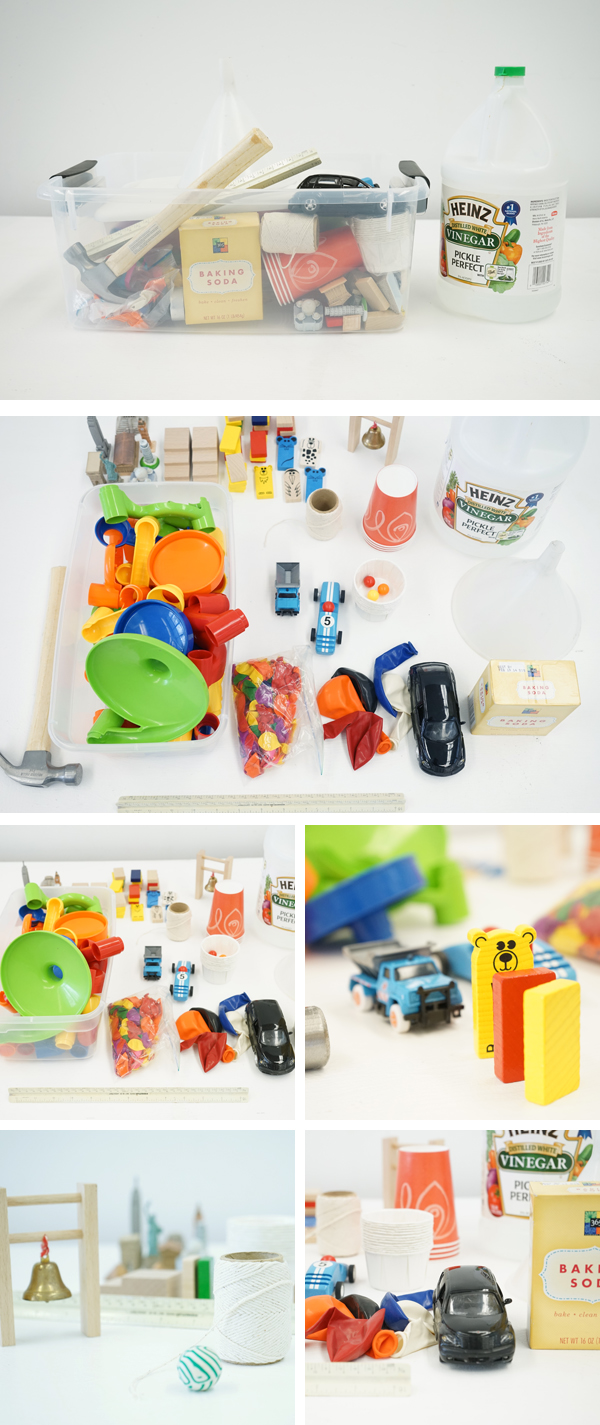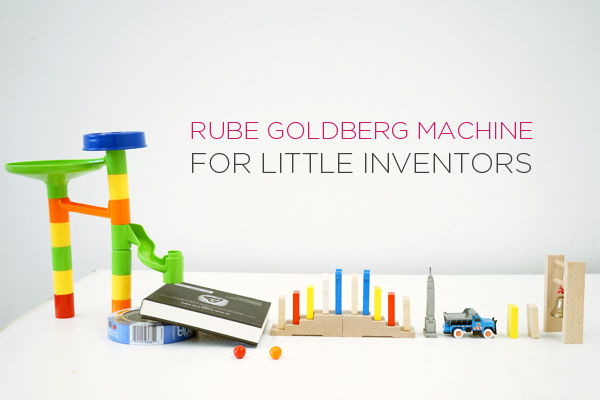Build a Rube Goldberg Machine with Kids
So, are you interested in building a Rube Goldberg-style machine with little kids? This post will give you a few tips and ideas to make your own complicated machine.
This project has long been on my to-do list with my kids. We are long-time fans of marble runs (see the resources page for recommendations), and extending our love for rolling balls and ramps into the world of Rube Goldberg was a no-brainer. And triple hurrah for projects that celebrate STEM and STEAM learning. We were on the hunt for easy Rube Goldberg ideas, watched a few videos, and came up with this fun solution that works for young children.
About Rube Goldberg
For the uninitiated, Rube Goldberg was an American Pulitzer Prize winning cartoonist, sculptor, author, engineer, and inventor, and his work is a classic example of the melding of art and science. Goldberg began his career as an engineer, and later became a cartoonist who drew elaborate illustrations of contraptions made up of pulleys, cups, birds, balloons, and watering cans that were designed to solve a simple task such as opening a window or setting an alarm clock. Interestingly, Goldberg only drew the pictures, and never built any of his inventions. However, these pictures have since served as inspiration for makers and builders who want the challenge of making wild inventions to solve everyday problems. 

And apparently, Rube Goldberg is a now an adjective in the dictionary! You can read more about Goldberg here.

Step 1: Get Inspired
First things first, you’ll want to watch some Rube Goldberg contraptions in action to get inspired. My kids and I LOVE this video from OK Go. It’s incredible complicated, but oh-so-amazing, so don’t think for one hot second that you’ll be able to replicate this with little kids.
Step 2: Solve a Problem
Next, come up with a simple problem that you’re trying to solve. For example:
- Ring a Bell
- Pop a Balloon
- Open a Door
- Shut a window
- Put out a candle
Once you have a problem sorted out (and don’t worry – you can change this later if you want), gather supplies…
Step 3: Gather Supplies
You can print out the following list here.
Collect a bucket-full of supplies and then lay them out so they’re easily seen. These can largely be found in your home or classroom — start with what you have! You will most likely start with some of these basics, and then forage your home or classroom for more supplies as you go. Here are some ideas to get you started:
Things that Roll
- Marbles
- Balls: Tennis, Baseball, Bowling, etc.
- Toy Cars
- Dominoes
- Skateboard
- Roller Skate
- Mousetrap
Things that Move
- Mousetrap
- Dominoes
- Toaster
- Fan
Ramps
- Toy Train Tracks
- Marble Runs
- Books
- Trays
- PVC pipe
- Plastic tubing
- Gutters
Recyclables
- Cardboard
- Cereal Boxes
- Cardboard Rolls
- Plastic Water Bottles
- Cans
- Aluminum Foil
Household Materials
- Chopsticks
- Popsicle Sticks
- Ruler
- Wooden Blocks
- Bowl
- String
- Tape
- Sand
- Pins
- Hammer
- Balloons
- Water
- Fan
- Vinegar and Baking Soda
Step 4: Build Your Machine!
Once you have the supplies ready, start building. While the OK Go video (and others like it) includes some pretty complex machines and concepts, keep this simple for preschoolers. The basic concept that we’re exploring is that of a chain reaction, so anything that tips something else over (and so one) is what you’re going for. Don’t worry too much about building things like pulleys and levers for young children.
Take a look at our machine to get a sense of what’s possible.
Our Rube Goldberg Machine in Action
5 Tips for Success
- Success breeds enthusiasm, so keep the steps to a minimum. You can always add more as you go.
- Keep your expectations low
- Ask your child for ideas and input
- Work collaboratively
- Aim to have fun
A Note on Failure
As you test and try out different set-ups, you’ll undoubtedly fail a few times. I could have filled a 20 minute video with outtakes from all our misses (the balloon is a good example of that). But this is great news! Failure is an intrinsic piece of the invention process, and without these mistakes we won’t learn how things really work. So embrace failure and celebrate it as part of the learning process.
Next Steps: Full STEAM Ahead
- Ask: What other simple problems could we solve?
- Ask: What materials could we use?
- Ask: Why didn’t that work? How could we fix it or try it again?
- Encourage your child to problem solve by seeking out materials and moving objects.
Did you enjoy this project? Join the semi-secret Club TinkerLab on Facebook to swap and share more ideas like this.

More Projects like this one
Activate Learning with STEAM
If you’ve been a loyal TinkerLab fan (thank you! you mean the world to me.) you’ll know that I’m happiest sharing projects that live at the intersection of disciplines. Too often we’re quick to separate science from writing or math from art, but when we seek out ways to make interdisciplinary connections, learning can be more meaningful and novel discoveries can be made.

In that vein, over the next few weeks I’m joining a creative group of engineers, scientists, educators, and artists to launch a new series called STEAM Power, which celebrates interdisciplinary learning with projects that circle around STEAM (science, technology, engineering, art, and math) ideas. This week’s theme is REACT, and you can see the other reaction-related ideas here:
Stixplosions | Babble Dabble Do
Smoosh Painting | Meri Cherry
Color Changing Chemistry Clock | Left Brain Craft Brain
Zoom Ball | What Do We Do All Day?
Glowing Hands | All For The Boys
Rainbow Reactions | Lemon Lime Adventures
Colorful Chemical Reaction | Frugal Fun for Boys

댓글 없음:
댓글 쓰기